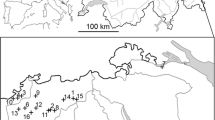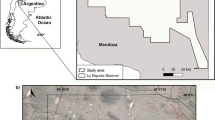Abstract
Lek-breeding species are characterized by a negative association between territorial resource availability and male mating success; however, the impact of resources on the overall distribution patterns of the two sexes in lek systems is not clear. The normalized difference vegetation index (NDVI) has recently emerged as a powerful proxy measure for primary productivity, allowing the links between the distributions of animals and resources to be explored. Using NDVI at four spatial resolutions, we here investigate how the distribution of the two sexes in a lek-breeding population of topi antelopes relates to resource abundance before and during the rut. We found that in the dry season preceding the rut, topi density correlated positively with NDVI at the large, but not the fine, scale. This suggests that before the rut, when resources were relatively scant, topi preferred pastures where green grass was widely abundant. The pattern was less pronounced in males, suggesting that the need for territorial attendance prevents males from tracking resources as freely as females do. During the rut, which occurs in the wet season, both male and female densities correlated negatively with NDVI at the fine scale. At this time, resources were generally plentiful and the results suggest that, rather than by resource maximization, distribution during the rut was determined by benefits of aggregating on relatively resource-poor leks for mating, and possibly antipredator, purposes. At the large scale, no correlation between density and NDVI was found during the rut in either sex, which can be explained by leks covering areas too small to be reflected at this resolution. The study illustrates that when investigating spatial organization, it is important: (1) to choose the appropriate analytic scale, and (2) to consider behavioural as well as strictly ecological factors.



Similar content being viewed by others

References
Boone RB, Thirgood SJ, Hopcraft JGC (2006) Serengeti wildebeest migratory patterns modeled from rainfall and new vegetation growth. Ecology 87:1987–1994
Bradbury JW, Vehrencamp SL (1998) Principles of animal communication. Sinauer, Sunderland
Bro-Jørgensen J (2001) Lek-breeding in topi antelopes (Damaliscus lunatus). Ph.D. thesis, University of London
Bro-Jørgensen J (2003) The significance of hotspots to lekking topi antelopes (Damaliscus lunatus). Behav Ecol Sociobiol 53:324–331
Bro-Jørgensen J (2008) The impact of lekking on the spatial variation in payoffs to resource-defending topi bulls, Damaliscus lunatus. Anim Behav 75:1229–1234
Bro-Jørgensen J, Durant SM (2003) Mating strategies of topi bulls: getting in the centre of attention. Anim Behav 65:585–594
Clutton-Brock TH (1988) Reproductive success—studies of individual variation in contrasting breeding systems. University of Chicago Press, Chicago
Davies NB (1991) Mating systems. In: Krebs JR, Davies NB (eds) Behavioural ecology—an evolutionary approach, 3rd edn edn. Blackwell, Oxford, pp 263–294
Duncan P (1975) Topi and their food supply. Ph.D. thesis, University of Nairobi
Dungan JL, Perry JN, Dale MRT, Legendre P, Citron-Pousty S, Fortin M-J, Jakomulska A, Miriti M, Rosenberg MS (2002) A balanced view of scale in spatial statistical analysis. Ecography 25:626–640
Efron B, Tibshirani RJ (1993) An introduction to the bootstrap. Chapman & Hall, London
ESRI (1996) Getting to know Arcview GIS: the geographical information system for everyone. Environmental Systems Research Institute, New York
Estes RD (1991) The behavior guide to African mammals. University of California Press, Berkeley
Franca H, Setzer AW (1998) AVHRR temporal analysis of a savannah site in Brazil. Int J Remote Sens 19:3127–3140
Gosling LM (1991) The alternative mating strategies of male topi (Damaliscus lunatus). Appl Anim Behav Sci 29:107–119
Gosling LM, Petrie M (1990) Lekking in topi—a consequence of satellite behavior by small males at hotspots. Anim Behav 40:272–287
Höglund J, Alatalo RV (1995) Leks. Princeton University Press, Princeton
Ims RA (1988) Spatial clumping of sexually receptive females induces space sharing among male voles. Nature 335:541–543
Kerr JT, Ostrovsky M (2003) From space to species: ecological applications for remote sensing. Trends Ecol Evol 18:299–305
Lahiri SN (2003) Resampling methods for dependent data. Springer, Berlin
McNaughton SJ (1988) Mineral nutrition and spatial concentrations of African ungulates. Nature 334:343–345
Mueller T, Olson KA, Fuller TK, Schaller GB, Murray MG, Leimgruber P (2007) In search of forage: predicting dynamic habitats of Mongolian gazelles using satellite-based estimates of vegetation productivity. J Appl Ecol. doi: 10.1111/j.1365-2664.2007.01371.x
Murray MG, Brown D (1993) Niche separation of grazing ungulates in the Serengeti—an experimental test. J Anim Ecol 62:380–389
Murray MG, Illius AW (2000) Vegetation modification and resource competition in grazing ungulates. Oikos 89:501–508
Musiega DE, Kazadi S-N (2004) Simulating the East African wildebeest migration patterns using GIS and remote sensing. Afr J Ecol 42:355–362
Pettorelli N, Mysterud A, Yoccoz NG, Langvatn R, Stenseth NC (2005a) Importance of climatological downscaling and plant phenology for red deer in heterogeneous landscapes. Proc R Soc Lond B Biol Sci 272:2357–2364
Pettorelli N, Vik JO, Mysterud A, Gaillard J-M, Tucker CJ, Stenseth NC (2005b) Using the satellite-derived NDVI to assess ecological responses to environmental change. Trends Ecol Evol 20:503–510
Rasmussen MS (1998) Developing simple, operational, consistent NDVI-vegetation models by applying environmental and climatic information. Part I. Assessment of net primary productivity. Int J Remote Sens 19:97–139
Ricotta C, Avena GC (1998) Fractal modelling of the remotely sensed two-dimensional net primary production pattern with annual cumulative AVHRR NDVI data. Int J Remote Sens 19:2413–2418
Roderick M, Noble IR, Cridland S (1999) Estimating woody and herbaceous vegetation cover from time series satellite observations. Glob Ecol Biogeogr 8:501–508
Serneels S, Lambin EF (2001) Impact of land-use changes on the wildebeest migration in the northern part of the Serengeti-Mara ecosystem. J Biogeogr 28:391–407
Tucker CJ, Sellers PJ (1986) Satellite remote sensing of primary production. Int J Remote Sens 7:1395–1416
Tucker CJ, Pinzon JE, Brown ME, Slayback DA, Pak EW, Mahoney R, Vermote EF, el Saleous N (2005) An extended AVHRR 8-km NDVI data set compatible with MODIS and SPOT vegetation NDVI data. Int J Remote Sens 26:4485–4498
Underwood R (1982) Vigilance behavior in grazing African antelopes. Behaviour 79:81–107
Verlinden A, Masogo R (1997) Satellite remote sensing of habitat suitability for ungulates and ostrich in the Kalahari of Botswana. J Arid Environ 35:563–574
Zinner D, Peláez F, Torkler F (2001) Distribution and habitat associations of baboons (Papio hamadryas) in Central Eritrea. Int J Primatol 22:397–413
Acknowledgements
We are grateful to Paul E. Loth and two anonymous reviewers for their comments, to Mada Hotels for logistic support, and to the Ministry of Science and Technology in Kenya, Narok County Council, the Senior Warden of Masai Mara National Reserve and Kenya Wildlife Service for permission to do field work. This research was supported by the Danish Research Agency and a Marie Curie Intra-European Fellowship within the 6th European Community Framework Programme to Jakob Bro-Jørgensen.
Author information
Authors and Affiliations
Corresponding author
Additional information
Communicated by Roland Brandl.
Rights and permissions
About this article
Cite this article
Bro-Jørgensen, J., Brown, M.E. & Pettorelli, N. Using the satellite-derived normalized difference vegetation index (NDVI) to explain ranging patterns in a lek-breeding antelope: the importance of scale. Oecologia 158, 177–182 (2008). https://doi.org/10.1007/s00442-008-1121-z
Received:
Accepted:
Published:
Issue Date:
DOI: https://doi.org/10.1007/s00442-008-1121-z



